
|
Roe Deer The Ecology of the European Roe Deer (Capreolus capreolus) INTRODUCTION Roe deer are one of only two species that can be considered indigenous to the British Isles, the other being the Red deer. Remains identified as Roe have been found dating back to the Interglacial period (400,000 BC) along with other species now extinct in Britain. There is only one species of Roe deer, believed to be divided into three subspecies. Considerable debate exists amongst the experts regarding the exact differences between the subspecies; this has been compounded by the fact that the majority of the world’s Roe population lives within the former Eastern Bloc. As travel restrictions ease, further detailed research should clarify the issue. The three subspecies are European, Siberian and Chinese. This paper is primarily concerned with the European Roe, Capreolus capreolus. There are significant differences between the subspecies. The Siberian Roe are approximately twice the size of European Roe. The latter stand between 60-75 cm at the shoulder with bucks weighing between 24 and 30 kg, whilst the does are 2-6 kg lighter. Chinese Roe fall somewhere in between these physical ends of the spectrum. Even amongst the same subspecies there can be a marked difference in body size, attributable to availability of food and climatic conditions, the two principal factors which determine the carrying capacity of a particular habitat. Antler development varies between the subspecies. Coronets of European Roe bucks sometimes coalesce. In Siberian and Chinese Roe the coronets are usually well separated. However, in the Siberian subspecies the back tines tend to develop a fork and the overall antler length is greater than that of the Chinese, with the shortest antlers belonging to European Roe. All subspecies grow the characteristic six-point head, with minor variations depending on the health of the deer. HISTORY AND DISTRIBUTION European Roe can be considered to have been continuously resident on the British mainland since the Postglacial period, crossing from Europe by means of the land bridge. Roe deer didn't reach Ireland at this time. With the retreat of the ice pack and the formation of the English Channel they became marooned on what is now mainland Britain. Since then the native Roe population has undergone dramatic fluctuations in numbers and distribution. Numerous through Roman and Saxon times, Roe suffered a steady decline through the mediaeval period. Having been protected by the Normans, Roe were later declared as being ‘beasts of the warren’ (unworthy of noble hunting) in 1338. This led to their becoming a food source to an expanding peasant population. By the late sixteenth century Roe were becoming increasingly scarce throughout England and were extinct in Wales. Scotland experienced a similar decline in numbers due in part to forest clearance and the rise of widespread sheep farming. A few small pockets survived in the southern counties of Scotland, with the remaining population confined to Highlands. With the growing interest in forestry and game shooting during the eighteenth and nineteenth centuries, the fortunes of Roe deer started to improve. A series of introductions into parks and wildlife collections in the Lake District, East Anglia and the South of England re-established the species in the early nineteenth century. It is worth noting the theory that the Roe of the Petworth Park Estate were never extinct and the present population evolved from animals contained within the wall. From these introductions, escapees and deliberate releases established wild colonies. Since then there has been a continuing spread across Britain and, aided by post war afforestation, Scottish Roe have now closed the distribution gap. Roe can now be found in all counties in England with a slow but recorded infiltration into Wales. The attempted introductions of Roe in Ireland, where there has never been any indigenous population, have met with limited success and Roe can be considered extremely rare if not non-existent across the Irish Sea. PELAGE Young Roe, born between late May and early June, are called kids or sometimes fawns. At birth, Roe kids have a dark brown coat which is heavily spotted with two distinct lines of white spots running from the nape of the neck either side of the dorsal to the rump. The sides and flanks are also spotted in white. The spots soon begin to fade and are usually gone in about 8-10 weeks. The kids then develop their first winter coat.
Roe have a very short tail, which is not visible without close physical examination and is an important distinguishing feature of the species. Both bucks and does are marked on the face with a white spot on the upper lip either side of the nose and the chin is also white. This coloration is more prominent in younger animals.
ANTLER DEVELOPMENT Roe deer are unusual amongst British deer in that they cast and re-grow their antlers in the winter when good food is scarce; other species develop their antlers over spring and summer. Buck kids develop a small knob (or button) on top of their pedicle during the first nine months of life. This knob is shed in early spring and the first antler begins to grow. Occasionally if habitat conditions have been favourable, a strong young buck may develop a classic six-point head in its first year. However, a four-point head or even just two spikes would be the norm. During its development, the growing antler is covered in a grey furry membrane known as velvet. This carries the blood vessels and nerves for the developing antler; the antler is bone growing on the outside of the body from the pedicles unlike horns, which are hollow and not cast each year. Should the velvet become damaged during the antlers’ growth, deformities can occur. The antlers are usually fully developed between March and April (earlier in older animals), when the increasing length of daylight causes a rise in testosterone levels. This causes the blood supply to the antler to be cut off. The velvet dries out, shrinks and is removed by the buck fraying its new antlers against saplings. During the period that the velvet is being removed, the buck is said to be ‘in tatters’ with dried velvet hanging in strips from the now hard antler. Whilst removing the velvet, damage is caused to young trees as the buck frays. It is whilst the buck is fraying saplings that the antlers become stained and coloured with tannin and sap from the bark, which changes the colour from white bone to a deep burnished brown. In areas with few trees like Salisbury Plain, antler colour is much paler due to lack of bark staining. It is the older bucks who clean their antlers first in readiness for spring.
Animals still in velvet in June may well have been injured or might be unwell for some reason. There is a condition in Roe which can lead to the development of what is known as a Perruque Head. This is normally caused by damage to a buck’s testicles which prevents the rise in testosterone which would normally signal the cessation of the blood supply to the antlers’ velvet. Consequently with a perruque the velvet continues to grow, forming a soft spongy mass which does not harden. This eventually becomes infected or fly blown and may result in the animal’s death.
HABITAT AND FEEDING Roe are herbivores and a highly adaptable species
found in a wide variety of habitats, ranging from open moor to
thick cover in conifer or deciduous woodland. Features that must
be present whatever the habitat are shelter and a variety of food
plants. The ideal habitat could be considered as coppice and pockets
of deciduous woodland on land that is not intensely farmed, this
linked by thick hedgerows and dotted with small copses. Roe are
Roe feed heavily during the spring and summer months, building up reserves to see them over the winter - the bucks will have new antlers to grow and most does will have a pregnancy to carry to full term. During late autumn and winter, activity decreases due to a reduced metabolic rate (a form of semi-hibernation). If not disturbed they can refrain from feeding for longer periods than normal. If disturbed then food will be required to replenish expended energy and poor food quality at this time of year necessitates greater intake in order to extract sufficient nutrients. Roe can be seen feeding at all times of the day depending on season and weather. The main times of activity are at dawn and dusk (crepuscular). If regularly disturbed they can become nocturnal, staying in close cover during daylight. Roe feeding in the open will head directly for cover if disturbed. Heavy rain and strong winds tend to suppress feeding activity and they will stay in cover. So a good time to find Roe feeding is after inclement weather as they quickly emerge to feed and dry off. Roe like to sunbathe and a sunlit clearing in cover will often be a favourite place to lie up. The type of soil in an area plays a major roll in the expected lifespan of Roe. A deer lives as long as it is able to chew its food enough to extract essential nutrients. In areas of harsh gritty soil teeth wear away more quickly than in areas of soft loamy soil, the sand and grit acting as an abrasive on the teeth. Tooth wear is location specific and with local knowledge, wear is a good guide to a deer’s age. In young animals very little wear will be seen, but in very old animals the teeth may be worn down to gum level and like this the animal will eventually die from malnutrition. An accurate way of assessing the age of an animal in its first year is by examination of the third pre-molar tooth. At birth this milk tooth is divided into three crowns. This tooth is replaced by the permanent 2 crown pre-molar by the time the animal is 13 months of age and it will generally have less staining than the other teeth. SOCIAL STRUCTURE Roe in Britain are not normally gregarious animals; hence they are not farmed. They are normally seen in loose family groups or as single animals. However in the Salisbury Plain area they mimic continental Field Roe in that in winter they can be seen in groups of up to 14 animals. The majority of a buck’s life is solitary. The doe will be accompanied by kids for most of the year and when she appears alone it is likely that there will a buck not too far away. Spring is a time of much activity. Individual bucks set up or re-establish territories where possible, however not all manage to achieve this. Bucks without status are pushed to the periphery of good areas where food and cover are less favourable. It is this action which leads to emigration and immigration between areas and is very significant in relation to Roe distribution. The does also drive the previous year’s kids from their home range in readiness to give birth to this year’s offspring. Many animals, having been ousted from their familiar surroundings, wander far afield seeking a favourable place to live. This results in an increase in road traffic accidents at this time of year. Roe will often congregate in an area not dominated by territorial bucks or does, known as a ‘coffee bar’ or more accurately, a ’non-disputed area’ where they can cause considerable damage. Occasionally a weak young buck who is not considered a threat by a stand buck, will be tolerated within a defined territory. This affords the young buck the benefit of good cover and food, enabling it to develop in physical stature and establish a knowledge of the area. Known as a Satellite buck, the young male risks being frequently chased and even injured by the resident buck when he attempts to court a female. It is very likely that this animal will eventually inherit the territory. Peripheral bucks reside in the core areas of the buffer zones between territories and make short raids into established territories in search of unattended females. If a buck has not established a territory by its third birthday, it is unlikely to ever achieve one. The does remain in their home range or territory for most of the year as this favours their offspring. A doe does not make physical boundary markings like the buck’s fraying, but will mark her territory with scent from the interdigital glands. Other does and eventually her own kids will be driven off, sometimes with physical force using the front hooves in a rearing and stabbing motion. A doe’s range may overlap that of other does and these will probably all overlap a buck’s territory. ANNUAL CYCLE The majority of Roe kids are born in late May and early June, although kids have been seen as early as March and as late as August in the South of England. Roe are unique amongst British deer in that the process of fertilisation after mating is subject to a biological mechanism called embryonic diapause or delayed implantation, as are other British mammals such as badgers and stoats. The rut takes place between late July and early August, but after fertilisation the embryo continues to float free in the uterus developing very slowly. It is not until late December or early January that the embryo becomes implanted in the uterine wall and rapid fetal development begins. Recent scientific research by several universities across Europe have shown female roe deer to have a single annual sexual cycle with a well-defined breeding season (they are described as monoestrous). During her one reproductive cycle, a doe sheds eggs from her ovaries, which are fertilised when they are in the fallopian tubes (the narrow tube between the ovaries and the uterus). Over the next 24 hours the embryo begins cell division as it passes into the uterus. When the developing embryo reaches 20 – 30 cell stage (known as a blastocyst) it enters a 5-month period where it remains unattached to the uterus. This period is known as delayed implantation or embryonic diapause. Left behind in the ovaries is the corpus luteum, one for each egg shed and are only a few millimetres in diameter. The corpora lutea release progesterone, which provides the embryo with nutrients to maintain the pregnancy. In species, other than the roe deer, the corpora lutea are normally an indication of pregnancy because they regress if fertilisation has not occurred. If the eggs fail to be fertilised in the roe doe, the corpora lutea in the non pregnant doe remain active for a period of five months, which coincides with the period of delayed implantation in the pregnant doe. This period in the non-pregnant doe is known as pseudo-pregnancy. Roe are one of only two species of mammal to have active corpora lutea during the period of delayed implantation, the other species being the armadillo. This means that the number of corpora lutea present in the ovaries during the period of delayed implantation do not give an accurate guide as to the number of embryos she might have or whether she is in fact even pregnant. During the period of delayed implantation the doe cannot know whether she is pregnant or not, because the embryos, during the delay period, do not send any 'signals' to the mother that they are there, hence she keeps the corpora lutea active whether she has embryos or not. She is in fact 'assuming' she is pregnant. The roe mother only recognises pregnancy when the fetus implants in the wall of the uterus in January. Therefore, if no embryos implant, the doe knows she is not pregnant and the corpora lutea start to regress quite rapidly from January onwards, whereas, in the pregnant doe, they remain active until the birth of the kids in late May. No other species of deer is monoestrus or employs delayed implantation, including the Siberian roe, as a reproductive strategy. Other deer species are described as polyoestrous and have many sexual cycles, usually occurring in the autumn.
It is in the rut that bucks are at their most pugnacious and inquisitive. They will approach a detected presence and even respond to an approximation of the call of a doe in oestrus, or the ‘pheep’ of a kid which may indicate that a doe is near by. A buck will approach expressing a challenge by stamping its foot, raising and lowering its head, licking its nose to improve its scenting ability and giving a challenging bark. Only when the buck has caught a human scent or recognised a threat will it bound off. However, another imitation call at this juncture is often enough to stop it in its tracks for a second look.
VOICE AND CALLS The main call of the Roe is a bark. The buck’s bark is usually a challenge call; the bark resembles that of a medium size dog, the timbre of the call becoming deeper as the animal ages. Bucks make a variety of other noises during the rut when pursuing a doe. However, the doe is the most vocal of the sexes and can be heard barking at most times of the year. The doe mostly barks as a warning to her kids and may continue to bark in various patterns for some time. Other calls consist of ‘pheeps’ and squeaks when communicating with her kids. The doe has a definite call when in oestrus and this is used to advertise her condition to any nearby bucks. Whilst Roe have a remarkable sense of smell, their eyesight is limited as they have monochromic vision, seeing in shades of black and white. They can detect light reflection from an unnatural material and it is this rather than colour that alerts Roe to danger. However Roe are able to detect the slightest physical movement and can spot a moving human form at considerable distances. SUMMARY Roe are probably the most fascinating and interesting species of British wild deer. They are also the most rewarding species to watch as, apart from the challenge of getting close enough to observe them, their characteristics and behaviour are thoroughly individualistic. Their many unique features, along with a natural elegance and grace, place them high on the list of our nation’s natural assets. With the planned expansion of the National Forest over the next twenty years, Roe will take full advantage in exploiting new habitats. The present Roe deer population is probably at its highest since the Middle Ages. BIBLIOGRAPHY Richard Prior, The Roe Deer- Conservation of a Native Species. Swan-Hill Press 1995. Richard Prior, Roe Stalking. Game Conservancy Ltd 1987. Richard Prior, Deer Watch. Swan Hill Press 1993. Ian Alcock, Chasing the Red and Following the Roe. Sauchenyard Press 1998. The British Deer Society, Basic Deer Management. Game Conservancy Publishing, Deer Management in Small Woodlands. Kenneth Whitehead, Practical Deer Stalking. AJ de Nahlik, Management of Deer and Their Habitat. Wilson Hunt 1992. Herbert Krebbs (translation by Lt Col Roy C Harms HQ USAREUR), Young or Old. F.C. Mayer Munchen-Solln. Liberg, O., Johansson, R., Andersen, R. and Linnell, J.D.C. (1998) The Function of Male Territoriality in Roe Deer. In: The European Roe deer: The Biology of Success, Scandinavian University Press UK, Oxford. Additional information supplied by Roger Lambert. Lambert, R.T., Ashworth, C.J., Beattie, L., Gebbie, F.E., Hutchinson, J.S.M., Kyle, D.J. & Racey, P.A. 1999. Temporal changes in reproductive hormones and conceptus-endometrial interactions during delayed implantation in the European roe deer (Capreolus capreolus). In: Advances in Deer Biology (Ed: Z. Zomborszky), Pannon University, Hungary. The Deer-UK Team are grateful to the University
of Aberdeen for allowing the use of the Roe buck photograph in
the Antler Development section. |
| Countrysports and Country Life are indebted
to the producers of the Deer UK site for permission to publish the
excellent material on deer species from their site. We would also
like to acknowledge the original sources of some of this material. We recommend all stalking enthusiasts or persons simply interested in deer, to pay a visit to the Deer UK site http://www.deer-uk.com |
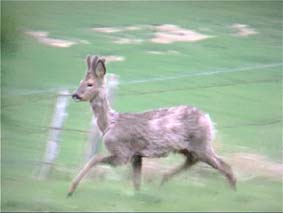 By September/October Roe are in full winter pelage. Their coat
colour ranges from dark brown to charcoal grey. The rump hairs
or caudal patch, erectile when the animal is alarmed, is white
and far more prominent in winter pelage. The caudal patch is important
in identifying the sexes during the winter when the bucks are
re-growing their antlers. The does have a distinctive downward
pointing tuft of hair at the base of the caudal patch referred
to as an anal tush, which gives the appearance of an ace of spades.
Bucks do not have this distinguishing feature and their caudal
patch resembles a kidney shape. The winter coat is shed from April
to May, younger animals changing first. Whilst the winter coat
is being shed, Roe take on a moth-eaten and unkempt appearance
as their coat falls out in chunks, usually starting around the
neck, revealing the summer coat underneath.
By September/October Roe are in full winter pelage. Their coat
colour ranges from dark brown to charcoal grey. The rump hairs
or caudal patch, erectile when the animal is alarmed, is white
and far more prominent in winter pelage. The caudal patch is important
in identifying the sexes during the winter when the bucks are
re-growing their antlers. The does have a distinctive downward
pointing tuft of hair at the base of the caudal patch referred
to as an anal tush, which gives the appearance of an ace of spades.
Bucks do not have this distinguishing feature and their caudal
patch resembles a kidney shape. The winter coat is shed from April
to May, younger animals changing first. Whilst the winter coat
is being shed, Roe take on a moth-eaten and unkempt appearance
as their coat falls out in chunks, usually starting around the
neck, revealing the summer coat underneath.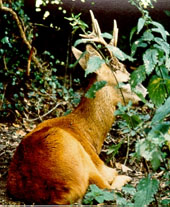 The summer coat of both male and female is chestnut red although
it can vary to a sandy yellow. Occasionally an animal with a darker,
black or piebald pelage is seen although this is uncommon. It
is often the unfortunate individual with a different or unusual
pelage that ends up being taken as a ‘unique’ sporting trophy.
The summer coat of both male and female is chestnut red although
it can vary to a sandy yellow. Occasionally an animal with a darker,
black or piebald pelage is seen although this is uncommon. It
is often the unfortunate individual with a different or unusual
pelage that ends up being taken as a ‘unique’ sporting trophy.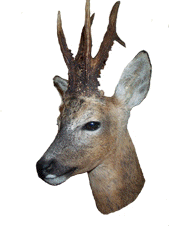 As ageing takes place, an increasing amount of grey develops
around the muzzle and the hair on the forehead becomes curly,
giving bucks an ‘old man’ appearance. The study of variegation
(different colouring) of a Roe’s head and face can be used as
an aid to ageing under field conditions.
As ageing takes place, an increasing amount of grey develops
around the muzzle and the hair on the forehead becomes curly,
giving bucks an ‘old man’ appearance. The study of variegation
(different colouring) of a Roe’s head and face can be used as
an aid to ageing under field conditions.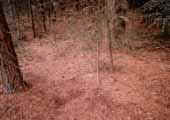 From April onwards mature bucks begin to mark out their territories.
Trees are now frayed for a different reason. This is boundary
scent marking; scent from the preorbital gland is deposited onto
the wet sapwood under the bark. This second fraying causes significantly
more damage than the cleaning of velvet. It is considered good
management policy to leave a territorial buck to dominate a new
plantation and act as a policeman against questing bucks seeking
territories. Removal of a stand buck often results in an influx
of younger males resulting in much frustrated fraying and considerable
damage. Frayed herbage normally has a V-shaped scrape at its base
which is made by the buck with its front hooves. This will also
be scent-marked by secretions from the interdigital glands situated
between the cleaves of the deer’s hooves.
From April onwards mature bucks begin to mark out their territories.
Trees are now frayed for a different reason. This is boundary
scent marking; scent from the preorbital gland is deposited onto
the wet sapwood under the bark. This second fraying causes significantly
more damage than the cleaning of velvet. It is considered good
management policy to leave a territorial buck to dominate a new
plantation and act as a policeman against questing bucks seeking
territories. Removal of a stand buck often results in an influx
of younger males resulting in much frustrated fraying and considerable
damage. Frayed herbage normally has a V-shaped scrape at its base
which is made by the buck with its front hooves. This will also
be scent-marked by secretions from the interdigital glands situated
between the cleaves of the deer’s hooves.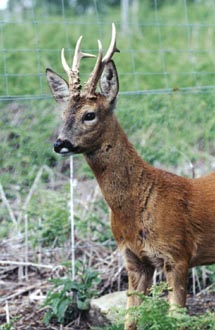 The typical European Roe
buck grows two, three point antlers consisting of a brow point,
a top point and a back point. The base of the antler is called
the coronet or burr and grows from the pedicle. The coronet increases
with size as the animal ages, sometimes growing together (coalescing)
in older animals. The beam of the antler is covered in tiny bony
nodules called pearling. Antler development in Roe is dependent
on food supply and age. A mature animal in poor condition will
only produce a small head. If conditions are better the following
year then a fine head may be grown. The average length for European
Roe antlers is between 20-30cm. The bucks shed their antlers between
October and December, the older bucks shedding first. New growth
starts almost immediately. Older bucks can be identified from
their antlers as the coronets begin to droop (like melting candle
wax) and they angle forward losing their crisp right angle to
the pedicle. The tines lose their well developed shape, becoming
less sharp, and sometimes there is slight palmation at the joint
of tine and beam. A buck in this condition is termed as ‘going
back’. Occasionally very old does will develop pedicles and sometimes
small antlers; this is an hormonal imbalance due to old age.
The typical European Roe
buck grows two, three point antlers consisting of a brow point,
a top point and a back point. The base of the antler is called
the coronet or burr and grows from the pedicle. The coronet increases
with size as the animal ages, sometimes growing together (coalescing)
in older animals. The beam of the antler is covered in tiny bony
nodules called pearling. Antler development in Roe is dependent
on food supply and age. A mature animal in poor condition will
only produce a small head. If conditions are better the following
year then a fine head may be grown. The average length for European
Roe antlers is between 20-30cm. The bucks shed their antlers between
October and December, the older bucks shedding first. New growth
starts almost immediately. Older bucks can be identified from
their antlers as the coronets begin to droop (like melting candle
wax) and they angle forward losing their crisp right angle to
the pedicle. The tines lose their well developed shape, becoming
less sharp, and sometimes there is slight palmation at the joint
of tine and beam. A buck in this condition is termed as ‘going
back’. Occasionally very old does will develop pedicles and sometimes
small antlers; this is an hormonal imbalance due to old age.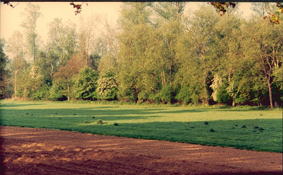 predominantly selective
browsers, however they also graze, feeding on shoots, herbs, grasses,
fruits, nuts, fungi, pine needles and twiggy browse during hard
times. Roe are opportunistic feeders with a liking for the exotic
as many gardeners have discovered. They can decimate rose beds
and low hanging baskets as well as vegetable gardens given the
chance. The feeding cycle of Roe is the same as with other British
deer. Being ruminants they feed in bouts followed by periods lying
up to chew regurgitated cud. However the digestive system of the
Roe is simpler than that of other species and this causes food
to pass through the alimentary tract relatively quickly. In turn
this necessitates more frequent feeding bouts depending upon the
quality and quantity of food available. Should the animals feel
secure then it is not unusual for them to lie where they have
fed.
predominantly selective
browsers, however they also graze, feeding on shoots, herbs, grasses,
fruits, nuts, fungi, pine needles and twiggy browse during hard
times. Roe are opportunistic feeders with a liking for the exotic
as many gardeners have discovered. They can decimate rose beds
and low hanging baskets as well as vegetable gardens given the
chance. The feeding cycle of Roe is the same as with other British
deer. Being ruminants they feed in bouts followed by periods lying
up to chew regurgitated cud. However the digestive system of the
Roe is simpler than that of other species and this causes food
to pass through the alimentary tract relatively quickly. In turn
this necessitates more frequent feeding bouts depending upon the
quality and quantity of food available. Should the animals feel
secure then it is not unusual for them to lie where they have
fed.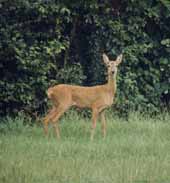 The breeding potential of a doe is dependant upon her body condition
at the beginning of the rut. An animal that has wintered in good
conditions will come into oestrus sooner than a doe that has had
to cope with a harsher environment. Yearling does (maidens) come
into oestrus a little earlier than mature does and are often covered
by bucks before the main rut begins. The doe can be considered
the more sexually ‘dominant’ of
The breeding potential of a doe is dependant upon her body condition
at the beginning of the rut. An animal that has wintered in good
conditions will come into oestrus sooner than a doe that has had
to cope with a harsher environment. Yearling does (maidens) come
into oestrus a little earlier than mature does and are often covered
by bucks before the main rut begins. The doe can be considered
the more sexually ‘dominant’ of 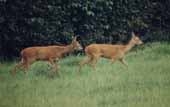 the sexes. If there is not a buck in the area when a doe comes
into oestrus, she will go and find one and will then lead it to
her preferred area with much leading on and chasing. Once satisfied
that the buck is strong and worthy of passing on its genes, copulation
will be permitted. The doe may be covered many times over a short
period. Should the doe not be fertilised by the first attempts
at mating, then she will come into season again a few days later
and be covered by the same or another buck. Contests over available
does by bucks can be ferocious and prolonged affairs. If the initial
challenging bark fails, head on fights occur until one concedes
that the other is the stronger by retiring. Injuries are not uncommon,
indeed they can sometimes prove fatal. Normally facial and neck
wounds can be evident, however if the vanquished buck is slow
to leave then puncture wounds to the hindquarters may be inflicted.
the sexes. If there is not a buck in the area when a doe comes
into oestrus, she will go and find one and will then lead it to
her preferred area with much leading on and chasing. Once satisfied
that the buck is strong and worthy of passing on its genes, copulation
will be permitted. The doe may be covered many times over a short
period. Should the doe not be fertilised by the first attempts
at mating, then she will come into season again a few days later
and be covered by the same or another buck. Contests over available
does by bucks can be ferocious and prolonged affairs. If the initial
challenging bark fails, head on fights occur until one concedes
that the other is the stronger by retiring. Injuries are not uncommon,
indeed they can sometimes prove fatal. Normally facial and neck
wounds can be evident, however if the vanquished buck is slow
to leave then puncture wounds to the hindquarters may be inflicted. In good conditions Roe have
a high fecundity rate. In the South of England twins are the norm
and in very good conditions triplets are not uncommon. Many triplet
fetuses are found during a post-mortem examination, though not
all would necessarily have been born alive. But if all three fetuses
are the same size, the indications are that all three will be
live at birth. Should one or more be smaller than the others,
then it is unlikely it would have been born alive. In a particularly
cold and/or wet early summer and autumn, the survival of all three
triplets is greatly reduced and it is normally buck kids that
fare worst. This could be due to nature perpetuating the species
by saving the does for the following breeding season.
In good conditions Roe have
a high fecundity rate. In the South of England twins are the norm
and in very good conditions triplets are not uncommon. Many triplet
fetuses are found during a post-mortem examination, though not
all would necessarily have been born alive. But if all three fetuses
are the same size, the indications are that all three will be
live at birth. Should one or more be smaller than the others,
then it is unlikely it would have been born alive. In a particularly
cold and/or wet early summer and autumn, the survival of all three
triplets is greatly reduced and it is normally buck kids that
fare worst. This could be due to nature perpetuating the species
by saving the does for the following breeding season.